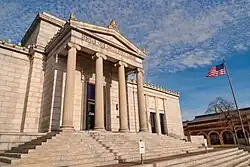Ralph Adams Cram
Ralph Adams Cram (December 16, 1863 – September 22, 1942) was a prolific and influential American architect of collegiate and ecclesiastical buildings, often in the Gothic Revival style. Cram & Ferguson and Cram, Goodhue & Ferguson are partnerships in which he worked. Cram was a fellow of the American Institute of Architects.
Ralph Adams Cram | |
|---|---|
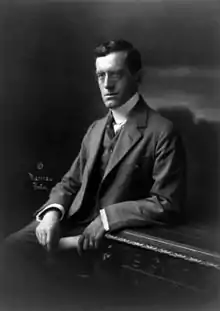 Cram in 1911 | |
| Born | December 16, 1863 |
| Died | September 22, 1942 (aged 78) Boston, Massachusetts, U.S. |
| Education | |
| Occupations |
|
| Spouse |
Elizabeth Carrington Read
(m. 1900) |
Early life
Cram was born on December 16, 1863, at Hampton Falls, New Hampshire, to William Augustine and Sarah Elizabeth Cram. He was educated at Augusta, Hampton Falls, Westford Academy, which he entered in 1875, and Phillips Exeter Academy.[1] He was a cousin of Ralph Warren Cram.
At age 18, Cram moved to Boston in 1881 and worked for five years in the architectural office of Rotch & Tilden, after which he left for Rome to study classical architecture.[2] From 1885 to 1887, he was art critic for the Boston Transcript. During an 1887 Christmas Eve mass in Rome, he had a dramatic conversion experience.[3] For the rest of his life, he practiced as a fervent Anglo-Catholic who identified as high-church Anglican. In the 1890s, Cram was a key figure in "social-controversial-inspirational" groups including the Pewter Mugs and the Visionists.[4]
In 1900, Cram married Elizabeth Carrington Read at New Bedford, Massachusetts. She was the daughter of Clement Carrington Read and his wife.[5] Read had served as a captain in the Confederate Army during the American Civil War. Elizabeth and Ralph had three children, Mary Carrington Cram, Ralph Wentworth Cram and Elizabeth Strudwick Cram.[1] The family burial site is at the St. Elizabeth's Memorial Churchyard.[6] The churchyard is adjacent to St Elizabeth's Chapel, which Cram designed.[7]
Career

Cram and business partner Charles Wentworth started business in Boston in April 1889 as Cram and Wentworth. They had landed only four or five church commissions before they were joined by Bertram Goodhue in 1892 to form Cram, Wentworth and Goodhue.[8] Goodhue brought an award-winning commission in Dallas (never built) and brilliant drafting skills to the Boston office.
Wentworth died in 1897 and the firm's name changed to Cram, Goodhue & Ferguson to include draftsman Frank Ferguson. Cram and Goodhue complemented each other's strengths at first but began to compete, sometimes submitting two differing proposals for the same commission. The firm won design of the United States Military Academy at West Point in 1902, a major milestone in their career. They set up the firm's New York office, where Goodhue would preside, leaving Cram to operate in Boston. He designed the sanctuary for the First Unitarian Society in Newton which represents elements of his signature ecclesiastical style and was built in 1905. From 1907 to 1909, Cram was the editor of Christian Art.[8]
.tiff.jpg.webp)
Cram's acceptance of the Cathedral of St. John the Divine commission in 1911 (on Goodhue's perceived territory) heightened the tension between the two. Architectural historians have attributed most of their projects to one partner or the other, based on the visual and compositional style, and the location. The Gothic Revival Saint Thomas Church was designed by them both in 1914 on Manhattan's Fifth Avenue. It is the last example of their collaboration, and the most integrated and strongest example of their work together.
Goodhue began his solo career on August 14, 1913. Cram and Ferguson continued with major church and college commissions through the 1930s. Particularly important work includes the original campus of Rice University, Houston, as well as the library and first city hall of that city. Also notable is Cram's first church in the Boston area, All Saints, Dorchester. The successor firm is HDB/Cram and Ferguson of Boston.
A leading proponent of disciplined Gothic Revival architecture in general and Collegiate Gothic in particular, Cram is most closely associated with Princeton University, where he served as supervising architect from 1907 to 1929, during a period of major construction. The university awarded him a Doctor of Letters for his achievements.[1] In 1907, he served as chairman of the American Institute of Architects' Committee on Education.[8]

For seven years he headed the Architectural Department at Massachusetts Institute of Technology.[9] Through the 1920s, Cram was a public figure and frequently mentioned in the press. The New York Times called him "one of the most prominent Episcopalian laymen in the country". His work was part of the architecture event in the art competition at the 1928 Summer Olympics.[10]
He made news with his defense of Al Smith during his electoral campaign, when anti-Catholic rhetoric was used, saying "I... express my disgust at the ignorance and superstition now rampant and in order that I may go on record as another of those who, though not Roman Catholics, are nevertheless Americans and are outraged by this recrudescence of blatant bigotry, operating through the most cowardly and contemptible methods."[11]
In around 1932, he designed the Desloge Chapel in St. Louis, MO, the Gothic chapel designed to echo the contours of the St. Chapelle in Paris. Desloge Chapel, which is associated with the Firmin Desloge Hospital and St. Louis University, in 1983, was declared a landmark by the Missouri Historical Society.[12][13] In 1938, he was elected into the National Academy of Design as an Associate Academician.
Views
Modernism
As an author, lecturer, and architect, Cram propounded the view that the Renaissance had been, at least in part, an unfortunate detour for western culture.[14] Cram argued that authentic development could come only by returning to Gothic sources for inspiration,[2] as his "Collegiate Gothic" architecture did, with considerable success. For his Rice University buildings, he favored a medieval north Italian Romanesque style, more in keeping with Houston's hot, humid climate.
A modernist in many ways, he designed Art Deco landmarks of great distinction, including the Federal Building skyscraper in Boston and numerous churches. For example, his design of the tower of the East Liberty Presbyterian Church, Pittsburgh, was inspired by the Empire State Building. His work at Rice was as modernist as medieval in inspiration. His administration building, his secular masterwork, has been compared by Shand-Tucci to Frank Lloyd Wright's work, particularly in the way its dramatic horizontality reflects the surrounding prairies.
The architectural historian Sandy Isenstadt wrote in a review of Cram's biography that "... (modernist) disdain (of Cram) turned out to be modernism's loss". Peter Cormack, director of London's William Morris Gallery, said regarding the critical neglect of Cram's work that it was "a phenomenon which has significantly distorted the study of America's modern architectural history... (Cram) deserves the same kind of international--and domestic--recognition accorded (all too often uncritically) to his contemporary Frank Lloyd Wright".
Politics
Cram argued that the United States would be better off under a constitutional monarchy.[15][16] He lays out some of his monarchist beliefs in his work Invitation to Monarchy, which appeared in The American Mercury in 1936.[17]
Religion
Raised Unitarian, Cram converted to Anglo-Catholicism after a youthful visit to Rome. He later joined The Episcopal Church in the United States upon returning to his home country. Throughout his life, Cram was devoted to liturgical and devotional practices revived by Anglo-Catholicism, including the cultus of King Charles the Martyr. He, along with other Anglo-Catholics, viewed Anglicanism as a "branch" of the one true Church, alongside the Roman Catholicism and Eastern Orthodoxy, and hoped for eventual unification with Rome.
Cram also co-founded the American branches of the Society of King Charles the Martyr and the Order of the White Rose. Traveling through Europe, Cram also befriended Catholic writers Hilaire Belloc and G. K. Chesterton, who have been accredited with influencing his views. He later became involved with a number of American Roman Catholic enterprises and co-founded the Catholic magazine Commonweal. Cram accepted papal primacy and frequently defended Catholicism against American anti-Catholic prejudice, though he never converted to the religion itself.[18]
Selected works
Residences

- The Birches, Garrison, New York, 1882
- House of the Rising Sun, 657 Highland Avenue, Fall River, Massachusetts, c.1890. Designed for Unitarian missionary Reverend Arthur May Knapp (1841–1921), it was inspired by a Japanese Pagoda.
- Rehoboth, Chappaqua, New York, 1891–92
- Richmond Court, Brookline, Massachusetts, 1896
- Watkins Manor House, Winona, Minnesota, 1924–27
- Moonstone Cottage, 559 York Street, York Harbor, Maine
Churches and religious buildings

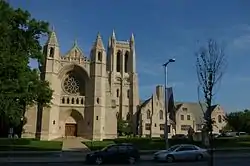
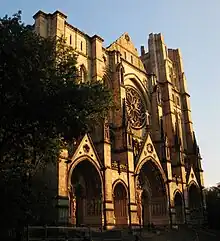
- All Saints' Church, Ashmont, Massachusetts, 1892
- Christ Church, Hyde Park, Massachusetts 1892
- Church of St. John the Evangelist, Boston, Massachusetts, 1892
- Lady Chapel, Church of the Advent, Boston, Massachusetts, 1894
- Phillips Church, Exeter, New Hampshire, 1897
- All Saints Parish,[19] Brookline, Massachusetts, 1898
- Emmanuel Church, Newport, Rhode Island, 1900
- Calvary Episcopal Church, Pittsburgh, Pennsylvania, 1904
- Holy Cross Monastery, West Park, New York, with Henry Vaughan, 1904
- All Saints' Chapel, Sewanee: The University of the South, Sewanee, Tennessee, begun 1904, completed 1959
- La Santisima Trinidad pro-cathedral, Havana, Cuba, 1905
- Saint Thomas Church, New York City, 1905–13
- First Unitarian Society, Newton, Massachusetts, 1905–06
- Westminster Presbyterian Church, Springfield, Illinois, 1906
- St. Andrew's Episcopal Church, Denver, CO, 1907
- Cathedral Church of Saint Paul, Detroit, Michigan, 1908
- St. Philip's Church, Durham, North Carolina, 1908
- Russell Sage Memorial Church, Far Rockaway, New York, 1908-10[20]
- House of Hope Presbyterian Church, St. Paul, Minnesota, 1909–14
- St. Florian Church, Hamtramck, Michigan, 1910, expanded by Cram 1928
- All Saints Cathedral, Halifax, Nova Scotia, 1910
- Park Avenue Christian Church, New York City, 1911
- Church of the Covenant in the University Circle neighborhood of Cleveland, Ohio, 1911
- Cathedral of St. John the Divine, New York City, design taken over by Cram in 1911, unfinished
- All Souls Congregational Church, Bangor, Maine, 1912
- remodeling of Richard Upjohn's Grace Church, Providence, Rhode Island, 1912
- Saint Paul's Episcopal Parish, Malden, Massachusetts, begun 1913, unfinished
- Fourth Presbyterian Church, Chicago, Illinois, 1914
- Nave extension and Lady Chapel of Trinity Church, Princeton, Princeton, New Jersey, 1914.
- Chapel of St. Anne, Arlington, Massachusetts, 1915
- Sacred Heart Cathedral, Dodge City, Kansas (1916)
- All Saints Church, Peterborough, New Hampshire, ca 1916-20
- First Universalist Church, Somerville, Massachusetts, 1916-23[21]
- Chapel of Mercersburg Academy, Mercersburg, Pennsylvania, 1916–28
- Cole Memorial Chapel, Wheaton College, Norton, Massachusetts, 1917
- Trinity Episcopal Church, Houston, Texas, 1919
- Calvary Episcopal Church, Americus, Georgia 1919–21
- St. Mark's Episcopal Pro-Cathedral, Hastings, Nebraska, 1921–29
- Saint James Church, Lake Delaware, New York, 1922.[22]
- First Presbyterian Church, Lexington, Kentucky 1922
- The First Presbyterian Church, Tacoma, Washington, 1923
- Sacred Heart Church, Jersey City, New Jersey, 1923[23]
- St. James' Episcopal Church, New York City, rebuilt, 1924
- First Presbyterian Church, Utica, New York, 1924
- Pine Street Presbyterian Church, Harrisburg, Pennsylvania, 1926
- Westminster Presbyterian Church, Dayton, Ohio 1926
- First Presbyterian Church, Lincoln, Nebraska, 1925–27
- Chapel at St. George's School, Newport, Rhode Island, 1928
- Holy Rosary Roman Catholic Church, Pittsburgh, Pennsylvania, 1928
- First Presbyterian Church, Glens Falls, New York, 1928
- St. Paul's Episcopal Church, Winston-Salem, North Carolina, 1928
- Concordia Lutheran Church, Louisville, Kentucky, 1930
- Knowles Memorial Chapel, on the campus of Rollins College, Winter Park, Florida, 1931–32
- Christ Church United Methodist, New York City, 1931–33
- Chancel, Brown Memorial Presbyterian Church, Baltimore, Maryland, 1931
- Cathedral of Hope, Pittsburgh, Pennsylvania, 1932–35
- Christ Episcopal Church tower addition, Blacksburg Historic District, Blacksburg, Virginia, 1934
- Conventual Church of St. Mary and St. John, Cambridge, Massachusetts, 1936
- Monastery and chapel at the Society of St. John the Evangelist, Cambridge, Massachusetts, 1936
- All Saints Episcopal Church, Winter Park, Florida, 1941
Libraries & academic buildings
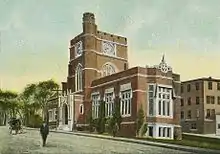

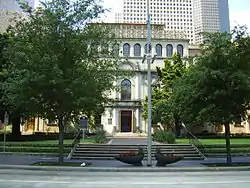
_-_Choate_Rosemary_Hall.jpg.webp)
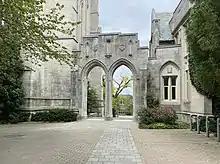
- Public Library, Fall River, Massachusetts 1899
- Boston Public Library, Parker Hill Branch, Roxbury, Massachusetts 1931[24]
- Deborah Cook Sayles Public Library, Pawtucket, Rhode Island, 1899
- The Mather School, Dorchester, Massachusetts, 1905
- Hunt Memorial Library, Nashua, New Hampshire, c.1906
- Sweet Briar College, Sweet Briar, Virginia, 1906–28
- Mary K. Benedict Hall
- Fletcher Hall
- Mary Harley Student Health and Counseling Center
- Mary Helen Cochran Library
- Masters Hall, The Masters School, Dobbs Ferry, New York, 1921
- Princeton University, Princeton, New Jersey, 1911–28
- Princeton University Graduate College, 1911–13
- Cleveland Tower, 1917
- Princeton University Chapel, 1928
- Rothschild Memorial Archway, 1929-1930
- Campbell Hall
- McCormick Hall
- University of Richmond, Richmond, Virginia, 1911–14
- Ryland Hall,
- Jeter Hall
- North Court
- Williams College, Williamstown, Massachusetts, 1910–22
- Phillips Exeter Academy, Exeter, New Hampshire
- Academy Building, 1914
- other buildings
- Rice University, Houston, Texas, 1910–16
- Lovett Hall (Administration Building)
- Mechanical Laboratory
- Campus master plan
- Lucius Beebe Memorial Library, Wakefield, Massachusetts, 1922
- The Choate School, Wallingford, Connecticut, 1924–28
- St. Andrews Chapel (now Seymour St. John Chapel)
- Archbold Infirmary, 1928 (now Archbold House)
- Julia Ideson Building of the Houston Public Library, Houston, Texas, 1926[27]
- Doheny Library, Campus of the University of Southern California, Los Angeles, 1931
- Bell Tower, Dwight Morrow High School, Englewood, New Jersey, 1932
- Saint Mary's Academy, Glens Falls, New York, 1932
- Wheaton College (Massachusetts), Upper Campus
- Sweet Briar College, Sweet Briar, Virginia, Campus
- South Dining Hall, University of Notre Dame, South Bend, Indiana, 1927
Other buildings
- Virginia War Memorial Carillon, Byrd Park, Richmond, Virginia, 1932
- U.S. Post Office and Courthouse aka J.W. McCormack Post Office and Courthouse, Boston, Massachusetts, 1933
- buildings at the Aisne-Marne American Cemetery and Memorial, Belleau, France, 1937
- buildings at the Oise-Aisne American Cemetery and Memorial, Fère-en-Tardenois, Aisne department, France, c. 1937
- New England Mutual Life Insurance Building, Boston, Massachusetts, 1941
Cram & Ferguson, after Cram's death
- Berkeley Building, Boston, Massachusetts, 1947
- Marsh Chapel of Boston University, Boston, Massachusetts, 1950
- St. Luke's Methodist Church (Monticello, Iowa), 1950
Publications
Cram wrote numerous publications and books on issues in architecture and religious devotion. Titles include:
- Impressions of Japanese Architecture, The Baker & Taylor Company, 1905
- Heart of Europe, MacMillan & Co. London, 1916 325pgs.
- The Substance of Gothic, Marshall Jones Company, Boston, 1917
- Farm Houses Manor Houses Minor Chateaux Small Churches in Normandy and Brittany, The Architectural Book Publishing Company, Paul Wenzel and Maurice Krakow, 1917
- Sins Of The Fathers, Marshall Jones Company, Boston, 1918
- Gold, Frankincense, and Myrrh, 1919
- Walled Towns, Marshall Jones Company, Boston, 1919
- Towards the Great Peace, Marshall Jones Company, Boston, 1922
- My Life in Architecture, Little, Brown, and Company, Boston, 1936
Cram also wrote fiction. A number of his stories, notably "The Dead Valley", were published in a collection entitled Black Spirits and White (Stone & Kimball, 1895). The collection has been called "one of the undeniable classics of weird fiction".[28] H. P. Lovecraft wrote, "In 'The Dead Valley' the eminent architect and mediævalist Ralph Adams Cram achieves a memorably potent degree of vague regional horror through subtleties of atmosphere and description."[29]
Professional memberships
Cram[1] was a
- Fellow of the:
- Boston Society of Architects.
- American Institute of Architects.
- North British Academy of Arts.
- Royal Geographical Society of London.
- American Academy of Arts and Sciences.[30]
- Member of the:
- American Federation of Arts.
- Architectural Association of London.
- Member of the clubs
- Puritan Club (Boston).
- Century Association (New York).
References
- "New Architect of St. John's Cathedral". Oswego Daily Times. September 22, 1911. p. 7d.
- Shand-Tucci, Douglass (2000). Built in Boston: City and Suburb: 1800-2000 (Rev. and expanded ed.). Amherst: Univ. of Massachusetts Press. pp. 162–163. ISBN 1-55849-201-1.
- Shand-Tucci, Douglass (1995). Ralph Adams Cram: Life and Architecture. Amherst: University of Massachusetts Press. pp. 68–70. ISBN 1-55849-061-2.
- Cram, Ralph Adams (1936). My Life in Architecture. Boston: Little, Brown, and Company. pp. 91–93.
- The National Cyclopædia of American Biography: Being the History of the United States as Illustrated in the Lives of the Founders, Builders, and Defenders of the Republic, and of the Men and Women who are Doing the Work and Moulding the Thought of the Present Time. J. T. White. January 1, 1916.
- Ralph Adams Cram: An architect's four quests
- "Saint Elizabeth's Church".
- "Cram, Ralph Adams", The Catholic Encyclopedia and Its Makers, New York, the Encyclopedia Press, 1917, page 35
 This article incorporates text from this source, which is in the public domain.
This article incorporates text from this source, which is in the public domain. - "Ralph Cram Dies; Noted Architect; Redesigner of the Cathedral of St. John the Divine Here Stricken in Boston; An Authority on Gothic; Fashioned Buildings for West Point and Princeton; Wrote on Religion". The New York Times. September 23, 1942. p. 25.
- "Ralph Adams Cram". Olympedia. Retrieved July 25, 2020.
- "Cram backs Smith at Bigotry Protest". The New York Times. September 14, 1928. p. 4.
- "School of Nursing | SAINT LOUIS UNIVERSITY". www.slu.edu. Archived from the original on January 17, 2004. Retrieved May 22, 2022.
- archon.slu.edu/?p=collections/findingaid&id=1&q=&rootcontentid=4
- Cram, Ralph Adams (1914). The Ministry of Art. Houghton Mifflin Company.
- "A King for America; THE END OF DEMOCRACY. By Ralph Adams Cram". New York Times. September 19, 1937.
- "Brief Sketches of the Contributers - Ralph Adams Cram" (PDF). Winter Park Topics Vol. 5 No. 7. February 19, 1938. p. 2.
- Cram, Ralph Adams (1936). "Invitation to Monarchy".
- Cram, Ralph Adams (2018). Gold, Frankincense, and Myrrh. Tumblar House. pp. 1–6.
- "A Tour of All Saints Parish - Page I". allsaintsparish.us. Retrieved September 16, 2019.
- Merrill Hesch (July 1986). "National Register of Historic Places Registration: Russell Sage Memorial Church / First Presbyterian Church of Far Rockaway". New York State Office of Parks, Recreation and Historic Preservation. Archived from the original on April 1, 2012. Retrieved October 3, 2008.
- National Register of Historic Places Registration: Massachusetts MPS First Universalist Church / First Universalist Church, Somerville, Massachusetts. File Unit: National Register of Historic Places and National Historic Landmarks Program Records: Massachusetts, 1964 - 2012. September 1989. Retrieved March 17, 2021.
- "Churches worth seeing, XII". December 2, 2013.
- Gomez, john (2008). "Sacred Heart Church in Jersey City, New Jersey A HISTORY AND ANALYSIS OF RALPH ADAMS CRAM'S SEMINAL SPANISH GOTHIC MASTERWORK" (PDF). Columbia University. Archived from the original (PDF) on May 10, 2014. Retrieved August 20, 2014.
{{cite journal}}: Cite journal requires|journal=(help) - "About Parker Hill".
- "Williams College - Chapin Hall". Kirkegaard Architectural Acoustics. February 4, 2016. Retrieved January 27, 2022.
- "Stetson Hall - 1922 (Francis Lynde Stetson '67)". Williams College. Retrieved January 27, 2022.
- Kleiner, Diana J. "Houston Public Library". Handbook of Texas Online. Texas State Historical Association. Retrieved July 14, 2023.
- Ashley, Mike, ed. (2004). The Mammoth Book of Sorcerers' Tales (1st Carroll & Graf ed.). New York: Carroll & Graf Publishers. p. 284. ISBN 0-7867-1408-5.
- Lovecraft, H.P. (1927–1935) Supernatural Horror in Literature. Yankee Classic website, online text. Retrieved 2013-05-14.
- Proceedings of the American Academy of Arts and Sciences Volume 56, 1921, p. 424.
Further reading
- Shand-Tucci, Douglass (2005). Ralph Adams Cram: An Architect's Four Quests: Medieval, Modernist, American, Ecumenical. Amherst, Mass. [u.a.]: Univ. of Massachusetts Press. ISBN 978-1-55849-489-3.
External links
- Held by the Department of Drawings & Archives, Avery Architectural & Fine Arts Library, Columbia University.
- Works by Ralph Adams Cram at Project Gutenberg
- Works by or about Ralph Adams Cram at Internet Archive
- Works by Ralph Adams Cram at LibriVox (public domain audiobooks)

- Why We Do Not Behave Like Human Beings, essay by Cram
- Cram & Ferguson Architects
- Book review of The Architecture of Ralph Adams Cram by Ethan Anthony
- Ralph Adams Cram at the Internet Speculative Fiction Database
- Ralph Adams Cram at Library of Congress, with 59 library catalog records
- Cram & Ferguson Google Map

